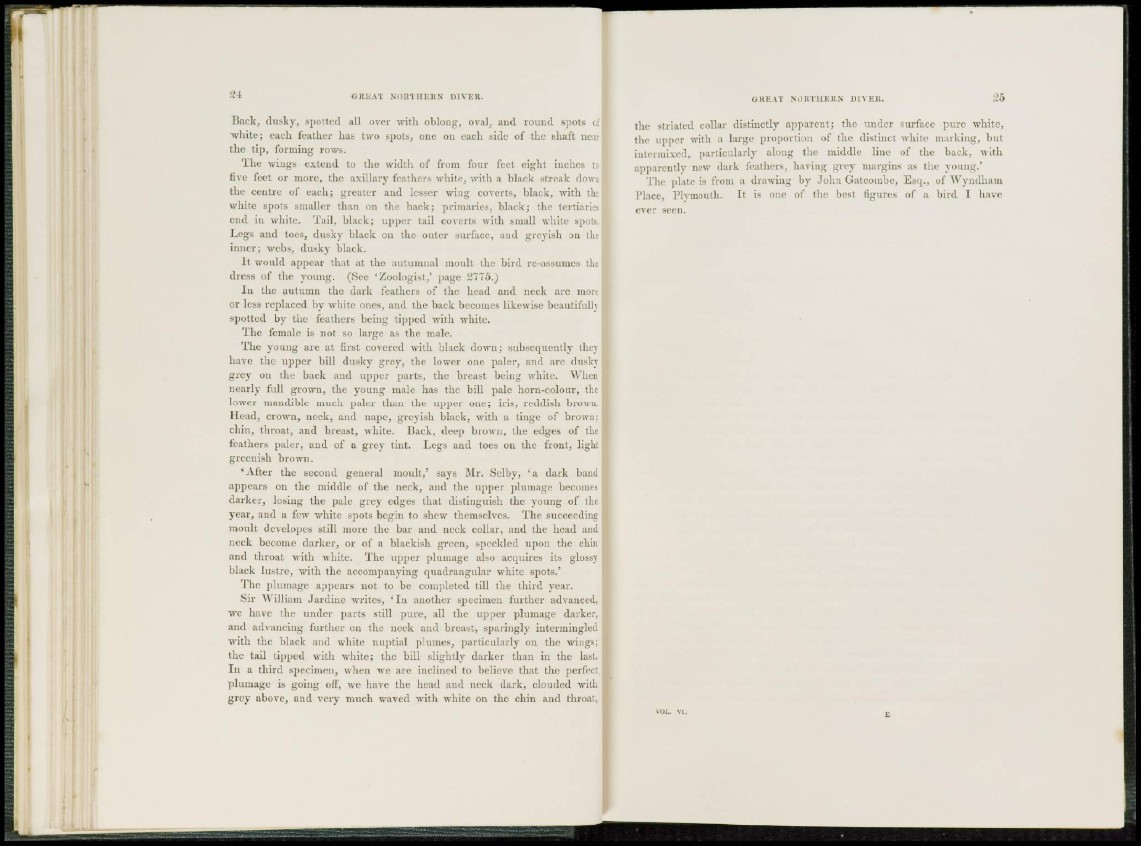
Back, dusky, spotted all over with oblong, oval, and round spots of
w h i t e ; each leather has two spots, one on each side of the shaft ne;ir
t h e tip, forming rows.
The wings extend to the width of from four feet eight inches to
five feet or more, the axillary feathers white, w i t h a black streak down
t h e centre of each; greater and lesser wing coverts, black, with the
white spots smaller than on the hack; primaries, b l a c k ; the tertiaries
e n d in white. Tail, black; upper tail coverts with small white spots.
Legs and toes, dusky black on the outer surface, and greyish on the
i n n e r ; webs, dusky black.
I t would appear that at the autumnal moult the bird re-assumes the
dress of the young. (See ' Z o o l o g i s t , ' page 2775.)
I n the autumn the dark feathers of the head and neck are more
or less r e p l a c e d by white ones, and the b a c k becomes likewise beautifully
s p o t t e d by the feathers being tipped with white.
The female is not so large as the male.
T h e young are at first covered with black down; subsequently they
have the upper bill dusky grey, the lower one paler, anel are dusky
g r e y on the back and upper parts, the breast being white. When
n e a r l y full grown, the young male has the bill pale horn-colour, the
lower mandible much paler than the upper one; iris, r e d d i s h browa.
H e a d , crown, neck, and nape, greyish black, with a tinge of brown:
chin, throat, and breast, white. Back, deep brown, the edges of the
feathers paler, and of a grey tint. Legs and toes on the front, light
g r e e n i s h brown.
' A f t e r the second general moult,' says Mr. Selby, ' a dark band
a p p e a r s on the middle of the neck, and the upper plumage becomes
d a r k e r , losing the pale grey edges that distinguish the young of the
y e a r , and a few white spots begin to shew themselves. The succeeding
moult dcvelopes still more the bar and neck collar, and the head and
neck become darker, or of a blackish green, speckled upon the chin
a n d throat with white. The upper plumage also acquires its glossy
black l u s t r e , with the accompanying quadrangular white spots.'
The plumage appears not to be completed till the t h i r d year.
Sir William J a r d i n e writes, ' I n another specimen further advanced,
we have the under parts still p u r e , all the upper plumage darker,
a n d advancing further on the neck and breast, sparingly intermingled
w i t h the black and white nuptial plumes, p a r t i c u l a r l y on the wings;
t h e tail tipped with w h i t e ; the bill slightly darker than in the last.
I n a t h i r d specimen, when we are inclined to believe that the perfect
plumage is going off, we have the head and neck dark, clouded with
g r e y above, and very much waved with white on the chin and throat,
t h e striated collar distinctly a p p a r e n t ; the under surface pure white,
the upper with a large proportion of the distinct white marking, but
intermixed, particularly along the middle line of the back, with
apparently new dark feathers, having g r e y margins as the young.'
The plate is from a drawing by John Gatcombe, Esq., of W y n d h am
Place, Plymouth. It is one of the best figures of a bird I have
ever seen.
VOL. VI.